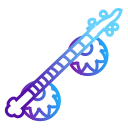RUDRA VEENA
Type: TAT VADYA
Rudra Veena is a stringed instrument, which is made of teak wood, metal, pumpkin, and Bamboo. This traditional instrument is found in various parts of North India. Majorly used in Northern Indian classical music.
It is played with plectrums worn on the index and middle finger of the right hand. Side strings are plucked with the plectrum on the small finger. Left side of the drone strings is plucked with the plectrum on the small finger. The traditional posture to play Rudra veena was vajrasan or darbari baithak (veena placed diagonally, upper gourd rests on the left shoulder while the lower gourd is placed on the right thigh and the fingerboard is laid near the chest). Later, players invented a new posture to play it, known as sukhasan (veena placed half diagonally, upper gourd is placed on the right thigh while the lower gourd is placed on the floor and the fingerboard is placed away from the chest). Difficulty faced while playing Rudra Veena in the traditional posture was reduced by the new one.
The word veena is believed to have been derived from the word vana, a string instrument mentioned in the Rig Veda. Katyayana, a vedic priest, further uses vana in Atharva Veda to denote an instrument with hundred strings. Vana means to produce sound (shabda) and speed (gati). Therefore, Vana was considered to be the stringed instrument which gave birth to Veena.
It is believed that Rudra Veena was created by Lord Shiva as a tribute to the beauty of Goddess Parvati. This instrument, believed to be first played by Shiva himself, is said to have spiritual powers. It was believed that Rudra Veena was too heavy for a woman's frail shoulders. Thus, women were not allowed to play it. However, the modern era has witnessed a few female players as well.
A long tubular body made of wood. Two large sized round resonators, made of fine quality gourds placed under the tube, at an equal distance from centre. Four playing strings, one of steel and three of copper tied to the hook on the lower end, stretched parallel to the tube and went to the ornate tuning pegs. Two drone strings mounted on the bridges on either side of the tube, stretched and tied to their respective pegs. Twenty four brass fitted raised wooden frets, fixed on the tube, with the help of wax. The resonators are richly decorated with wooden floral carvings. Carvings on the peg box as well. The lower end of the tube is chiselled out like a bird and serves as a base for the wide flat ivory bridge. While playing, one gourd rests on the left shoulder and the other on the right thigh. Played with wire plectrums worn on right hand fingers. An instrument used in Northern Indian classical music.
Rudra Veena has now become a rare instrument almost on the verge of extinction. Both, the craftsmen who create the instrument as well as its players are rarely found now. The instrument lost its importance in the early nineteenth century with the evolution of other stringed instruments such as – Surbahar, Sitar and Sarod, etc.
RUDRA VEENA in North India
Material: Teak wood, Metal, Pumpkin, Bamboo
Rudra Veena is an ancient instrument. A long tubular body made of teak wood or bamboo, attached to two hollow resonators/gourds of about fourteen inches in diameter on both sides. The gourds are made of dried or hollowed pumpkins. Twenty-four brass frets (in all the three octaves: mandra, madhya and tara) are fitted on the fingerboard and made immovable with the help of wax. Thin sharp-edged plates of brass are fixed on top of these frets called sara. It has 4 main strings and 3 chikari /rhythm (two on the right and one on the left) strings. All of these strings are tied with 3 nails called kakubha on one corner of the tube which has 8 regulators on either side to adjust the strings. Four main strings pass through the main bridge and before being tied up into their respective pegs, they pass through an upper bridge called meru. Chikari strings are mounted upon two side bridges, one on either side to meet their respective pegs. A fingerboard with a length of about three and a half feet holds the frets and strings together.
 Government of India
Government of India

































 Recognizing the ongoing need to position itself for the digital future, Indian Culture is an initiative by the Ministry of Culture. A platform that hosts data of cultural relevance from various repositories and institutions all over India.
Recognizing the ongoing need to position itself for the digital future, Indian Culture is an initiative by the Ministry of Culture. A platform that hosts data of cultural relevance from various repositories and institutions all over India.

